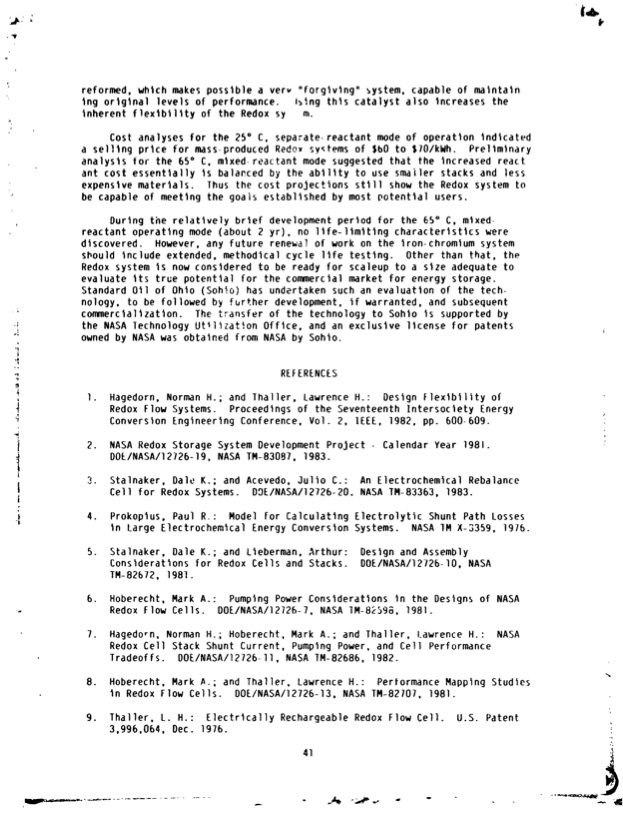
PDF Publication Title:
Text from PDF Page: 044
reformed, which makes posslble a verv "forglvingu bystem, capable of rnaintaln ing orlginal levels of performance. lsing this catalyst also Increases the inherent flexlbility of the Redox sy m. Cost analyses for the 25" C, separate-reactant mode of operation indicated a selling price for mass-produced Rsdor syqtems of SbO to $70/kWh. Prellminary analysis for the 65" C, mlxed-reactant mode suggested that the increased react ant cost essentlally is balanced by the abllity to use smaller stacks and less expenslve materials. Thus the cost projections s t i l l show the Redox system to be capable of meeting the goals established by most potential users. During the relatively brlef development period for the 65" C, mixed- reactant operating mode (about 2 yr), no life-limiting characterlstlcs were discovered. However. any future renewal of work on the iron-chromium system should include extended, methodical cycle l i f e testing. Other than that, the Redox system i s now considered to be ready for scaleup to a slze adequate to evaluate i t s true potential for the comnercial market for energy storage. Standard O i l of Ohio (Soh!o) has undzrtaken such an evaluatlon of the tech- nology, to be followed by fbrther development, if warranted, and subsequent comnerclalization. The transfer of the technology to Sohlo is supported by the NASA Technology Utlll;at!on Office, and an exclusive ljcense for patents owned by NASA was obtained from NASA by Sohio. 1. Hagedorn, Norman H.; and Thaller, Lawrence H.: Design flexlbility of Redox Flow Systems. Proceedings of the Seventeenth Intersociety Energy Conversion Engineering Conference, Vol. 2, IEEE, 1982, pp. 600-609. 2. NASA Redox Storage System Development Project - Calendar Year 1981 DOL/NASA/12726-19, NASA TM-83057, 1983. 3. Stalnaker, Dale K.; and Acevedo, J u l i o C.: An Electrochemical Rebalance C e l l f o r Redox Systems. D3E/NASA/12726-20. NASA TM-83363, 1983. 4. Prokopius, Paul R.: Model for Calculating Electrolytic Shunt Path Losses i n Large Electrochem~calEnergy Conversion Systems. NASA 1M X-2359, 1976. 5. Stalnaker, Dale K.; and Lieberman, Arthur: Design and Assembly Conslderatlons for Redox Cells and Stacks. DOE/NASA/12726-10, NASA TM-82672, 1981. 6. Hoberecht, Mark A.: Pumping Power Considerations in the Designs of NASA Redox F low C e l l s . DOE/NASA/12726- 7, NASA TM-8259i3. 1981 . 7. Hagedorn, Norman H.; Hoberecht, Mark A.; and Thaller, Lawrence H.: NASA Redox Cell Stack Shunt Current, Pumping Power, and Cell Performance T r a d e o f f s . DOE/NASA/12726-11, NASA TM-82686, 8. Hoberecht, #ark A . ; and Thaller, Lawrence H.: i n Redox Flow C e l l s . DOE/NASA/12726-13, NASA 1982. Performance Mapping Studies TM-82707, 1981. 9. Thaller, L. H.: Electrically Rechargeable Redox Flow Cell. U.S. Patent 3,996,064, Dec. 1976.PDF Image | NASA Redox Storage System Development Project

PDF Search Title:
NASA Redox Storage System Development ProjectOriginal File Name Searched:
19850004157.pdfDIY PDF Search: Google It | Yahoo | Bing
CO2 Organic Rankine Cycle Experimenter Platform The supercritical CO2 phase change system is both a heat pump and organic rankine cycle which can be used for those purposes and as a supercritical extractor for advanced subcritical and supercritical extraction technology. Uses include producing nanoparticles, precious metal CO2 extraction, lithium battery recycling, and other applications... More Info
Heat Pumps CO2 ORC Heat Pump System Platform More Info
| CONTACT TEL: 608-238-6001 Email: greg@infinityturbine.com | RSS | AMP |